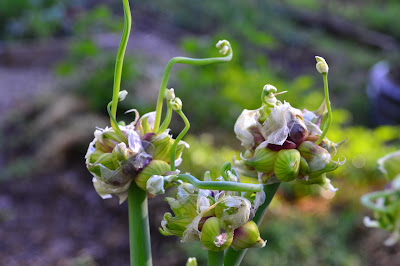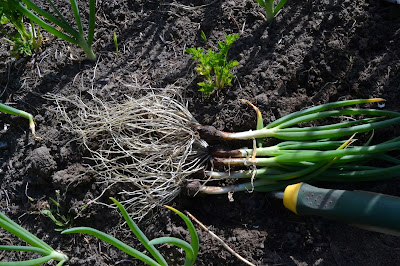One thing I have learned is that many vegetables - especially those in the onion tribe - will overwinter at temperatures below zero without any protection at all if they are robust enough on the fall to become dormant at their own pace.
 |
| Blooming scallion or "green onion" in June |
For example, I almost always leave some scallions, or green onions, in the ground every fall, and they green up pretty fast in the spring and may be harvested for a few weeks before they start blooming. I let the overwintered plants send up a flower stalk, or scape, and go to seed every year. I collect most of the seed by shaking the inflorescence, or flower head, into a paper bag once I can see a black speck inside each tiny flower. Some seed always spills onto the soil as I go along, germinates within a week or so, and "voila," I have a self-perpetuating scallion patch.
It should be noted, however, that the scallion plant dies after it blooms in the second growing season, classifying it as a biennial.
A perennial onion - one that lives year after year after year - goes by the name of Egyptian walking onion, or tree onion, or top-setting onion.
 |
| Walking onion patch in June |
These onions are different because they create top sets - a cluster of bulblets - on top on the flower stalk instead of traditional flowers with seeds.
They are said to "walk," because as the bulblets develop and get heavier, if left unattended the whole stalk will topple over and the bulblets will plant themselves 12 to 18 inches from the "mother plant."
After a few years of this you might have nothing but walking onions in your garden, so I leave my clump of mother plants in the ground and snap off the bulblet clusters each summer once each bulblet reaches marble size, or so.
 |
| Clusters of bulblets |
The clusters can easily be broken apart, leaving you with individual bulblets. Some people peel and pickle these, but I have not tried that.
I think ahead to early next spring - April - when harvesting anything from the garden is a real delight.
Sometime around mid summer I prepare a little patch of soil by loosening it with a fork, punch holes an inch or two apart with my index finger or a stick, and drop a bulblet - pointy side up - into each hole and cover it.
They sprout up pretty fast, and you'll have small green onions by fall.
 |
| A new walking onion patch in late August |
 |
| Freshly dug green walking onions in April |
I carefully dig them with a hand trowel, rinse them off with the hose and bring them into the kitchen to trim them up. Cut off the roots with a paring knife and peel off the brown outer skin.
Beautiful green onions! They will keep, wrapped in a paper towel inside a plastic bag in the fridge for several weeks.
 |
| Green walking onions ready to eat along with overwintered baby kale |
I have found that I can leave them in the ground and harvest them as needed until around June 1, when the young plants try to form their own top sets and start getting "woody."
I've also observed that out of my mother plants, side shoots sprout which can be broken off below ground level and used like leeks in early spring.
Anyone nearby who wants to start a patch of Egyptian walking onions can contact me from July-August for bulblets to plant in your garden.
No comments:
Post a Comment